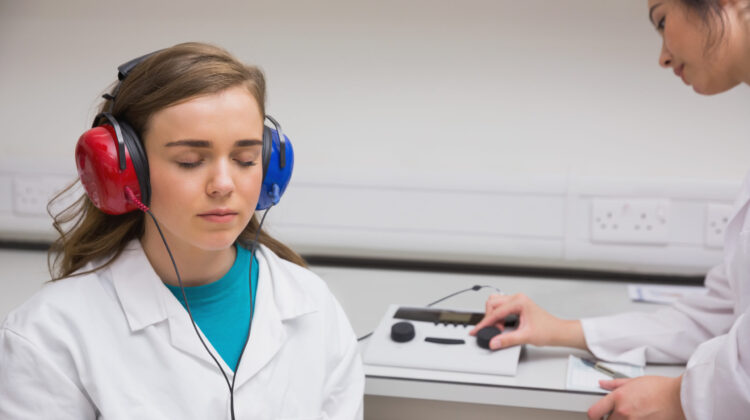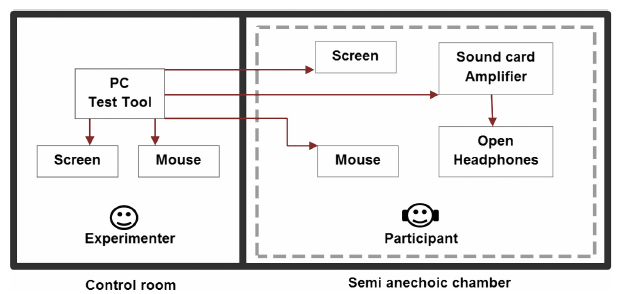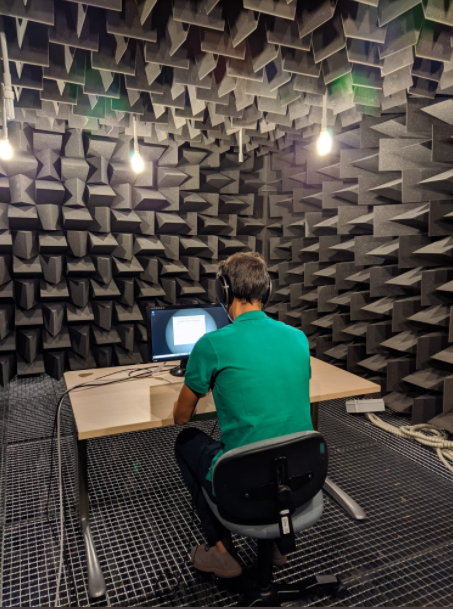
Last June 24th, Daniel de la Prida defended his PhD thesis [1] at the Technical University of Madrid (Spain). His research focused on the assessment of the subjective perception both in architectural and environmental acoustics. In the following, a summary of Daniel de la Prida’s research (mostly focused on room acoustics) is given. All the information presented here was taken from references [1-8], i.e. his PhD thesis as well as his published papers.
Dr. Daniel de la Prida defending his PhD at the Technical University of Madrid
Background
Different indicators are often employed in acoustics to assess, quantify, verify and certify either acoustic comfort for the end-users or compliance with norms and regulations in force. The aforementioned metrics have been developed over the years trying to have the human dimension (i.e. the subjective side of sound) into account. However, research is continuously focusing on trying to improve these existing parameters as well as developing new ones which better correlate with the human perception of sound. To that end, perceptual experiments, such as listening tests and in-situ surveys, are often the main tool when carrying out these investigations.
Listening tests
Listening tests are laboratory subjective tools that allow the assessment of a certain objective (e.g. annoyance) caused to the listener by a given audio input, often played through the use of headphones. In this manner, often a set of test participants are asked about their subjective perception of different sound stimuli with the ultimate aim of understanding how the auditory system reacts to those audio inputs.
Typical experimental equipment setup for a listening test
More specifically, listening tests in room acoustics are said to have three main purposes [2]:
- Describe the just noticeable differences (JNDs) of room acoustical parameters.
- Evaluate whether the difference between two or more stimuli is perceptible or not.
- Address the preference of listeners in room acoustics.
Designing a listening test is a daunting task, since it involves the interaction between different entities (experimenter, participant and test interface) and factors (experimental conditions). Consequently, they should be designed very carefully to minimise possible effects that could affect the results. Along those lines, the main drawback with listening test nowadays is the heterogeneity of methodologies used when carrying them out. The latter leads to difficulties when performing meta-analyses, comparing different studies using different methods, subjected to different sources of bias [2].
The main aim of Daniel’s PhD thesis was to provide methodological contributions that facilitate the definition of homogeneous, accurate and minimally biased methodologies with highly informative analysis tools for the performance of perceptual tests in the areas of sound insulation, room acoustics and soundscapes.
Types of listening tests
One of the first great contributions to the field of perceptual acoustics of Daniel was the extremely detailed investigation of the existing and most widely used types of listening tests currently employed not just in different fields of acoustics (architectural acoustics, environmental acoustics and room acoustics), but also in other areas of sensory evaluation (e.g. food industry), where these types of tests have a greater background and where the features of the different methodologies has, up to date, been more thoroughly studied.
In his last paper [2] Daniel divided room acoustics listening tests into two main families:
- Integrative scaling tests, where participants are asked to give scaled answers to one or several questions regarding their perception of the presented stimuli. These tests are mainly used to address preference and quality.
- Discrimination tests, often employed to check whether or not subtle differences can be perceived by the listener. Here, participants are simply asked to judge whether a difference exists between several stimuli or to identify the stimulus with more or less of an attribute (e.g. loudness and/or annoyance usually in sound insulation; clarity, reverberation, or intelligibility in room acoustics).
Two subtypes, in turn, exist:
- Attribute-related: the individuals are asked to identify stimuli based on a certain attribute.
- Overall tests: the participants only have to determine if there is a difference between the stimuli or to identify the stimulus that is different.
Thurstonian models
In [2], Daniel’s latest paper, listening tests were carried out in the field of room acoustics in order to evaluate the operational power of seven overall difference testing protocols (all of them pertained to overall tests –of different subtypes not explained here for the sake of simplicity). Some of the listening tests tried are commonly used in acoustics, and others potentially applicable to room acoustics but, as of today, usually applied in other fields of sensory evaluation. In this publication Daniel gathered a large sample of 134 participants, which is well over the usual sample size other researches had up to date used.
The main aim was to compare the operational (i.e. experimental) power and the influence of the several sources of bias for the various protocols of the listening tests studied; ultimately aiming at identifying and proposing the best method for carrying out listening tests in room acoustics. This was done by carrying out different listening tests, where the participants had to assess the difference between different confusable auralisations of the same room. To that end, use was made of Thurstonian models, also one of the main contributions of Daniel´s research to the field of listening tests in general and room acoustics in particular.
Without going too much into detail, Thurstonian models state that a certain stimulus follows a probability distribution function of neural input. Therefore, when performing listening tests, two slightly-different stimuli can be represented by two closely placed perceptual distributions. This distance between distributions, often measured in terms of standard scores, can be used to assess perceptual differences between stimuli. The latter is possible because this distance is a very robust measure of discrimination (i.e. it is independent of the test protocol and not sensitive to effects such as those of memory and adaptation by the subject to the test protocol). In this way, the results can be reliably compared on the basis of this measure independently of the protocol employed, thus assessing the operational power of the test methods. For more information about those models, see e.g. [1, 2, 5].
Main contributions
Daniel not only came up with a methodological of listening test for different areas of acoustics, but also on a transversal homogenisation. The latter could eventually facilitate the description of a common methodological framework based on difference testing that would allow the use of highly informative analysis methods barely employed so far in acoustics such as the Thurstonian models.
Congratulations, Dr. de la Prida, and thank you very much for the knowledge you contributed with to the field of acoustics, and that now you will keep passing on to your students as assistant professor at the University.
Author: Dr Juan Negreira Montero, Concept Developer for Office Environments at Ecophon
References
[1] D. de la Prida: Subjective Evaluation in Acoustics Through Listening Tests: Difference Testing in Sound Insulation, Room Acoustics and Soundscapes, PhD Thesis, E.T.S.I. y Sistemas de Telecomunicación (Polytechnical University of Madrid), 2021.
[2] D. de la Prida, A. Pedrero, L.A. Azpilicueta-Ruiz, M.A. Navacerrada: Listening tests in room acoustics: Comparison of overall difference protocols regarding operational power, Applied Acoustics 182, 108186, 2021.
[3] C. Monteiro, M. Machimbarrena, D. de la Prida, M. Rychtarikova: Subjective and objective acoustic performance ranking of heavy and light weight walls, Applied Acoustics 110, 268-279, 2016.
[4] D. de la Prida, A. Pedrero, M.A. Navacerrada, C. Díaz: Relationship between the geometric profile of the city and the subjective perception of urban soundscapes, Applied Acoustics 149, 74-84, 2019.
[5] D. de la Prida, A. Pedrero, M.A. Navacerrada, A Diaz-Chyla, Methodology for the subjective evaluation of airborne sound insulation through 2-AC and Thurstonian models, Applied Acoustics 157, 107011, 2020.
[6] D. de la Prida, A. Pedrero, M.A. Navacerrada, A. Díaz-Chyla: An annoyance-related SNQ for the assessment of airborne sound insulation for urban-type sounds, Applied Acoustics 168, 107432, 2020.
[7] D. de la Prida, A. Pedrero, L.A. Azpicueta-Ruiz, M.A. Navacerrada, C. Díaz: Does the method matter? A review of the main testing methods for the subjective evaluation of room acoustics through listening tests. Proceedings of 23rd International Congress on Acoustics, 7887-7894, 2019.
[8] D. de la Prida, A. Pedrero, C. Díaz, M.A. Navacerrada: Assessment of the relation between psychoacoustic parameters and the subjective perception of urban soundscapes, The Journal of the Acoustical Society of America 141 (5), 3622-3622, 2017.





